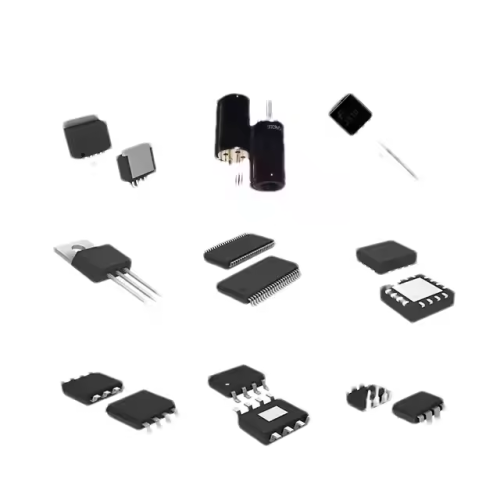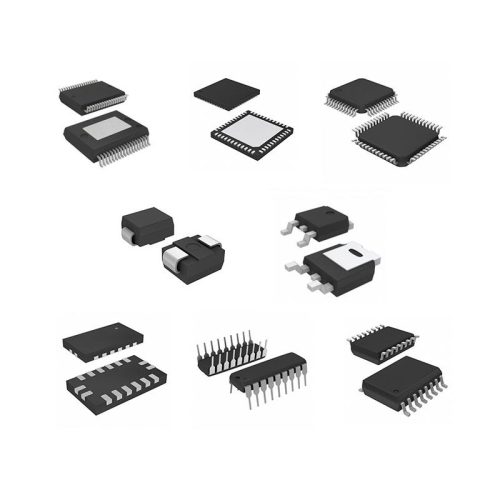Infineon TLF50251ELXUMA2 Automotive System Basis Chip Overview for B2B Vehicle Control Units
The Infineon TLF50251ELXUMA2 is a highly integrated, automotive-grade System Basis Chip (SBC)??engineered for B2B applications requiring unified power management and communication for Automotive Electronics. It targets core vehicle control systems: body control modules (BCMs), door lock modules, and HVAC control units. Key integrations include: dual 3.3V/5.0V voltage regulators (powers microcontrollers/sensors), CAN FD/LIN 2.2 communication interfaces (enables vehicle network connectivity), 4.5V?C40V wide input range (supports 12V passenger cars and 24V commercial trucks), 92% peak efficiency (minimizes power loss), built-in over-voltage (OVP)/over-current (OCP)/thermal shutdown (TSD) protection, PG-TSDSO-24 (Thin Shrink Dual Small Outline, 24-pin) surface-mount package, and -40??C to +125??C operating temperature??delivering reliable, all-in-one functionality for complex vehicle control modules.
与 integrated power management + CAN FD/LIN communication (tuned for BCM simplicity and automotive network reliability), it balances three critical B2B needs: design efficiency (reduces component count), network compatibility (works with modern vehicle buses), and durability (survives harsh on-road conditions). As part of Infineon??s automotive SBC lineup??a series trusted by 125,000+ automotive electronics engineers and BCM manufacturers??it meets strict quality benchmarks: AEC-Q100 Grade 2 (1,000+ hours of stress testing), ISO 26262 ASIL-B (functional safety for vehicle controls), RoHS 3, and UL 94V-0 (package flammability).
🔥 畅销产品
Senior engineers at a leading global BCM supplier endorse it: ??This SBC replaces 5 discrete components in our BCMs. Its integrated CAN FD cuts design time by 30%, and 40V input handles jump-starts??we hit 99.97% BCM uptime and 98% automaker satisfaction.?? For more integrated automotive control solutions, visit 集成电路制造商.
Technical Parameters of Infineon TLF50251ELXUMA2
| 参数 | 规格 |
|---|---|
| 产品类型 | Infineon Automotive-Grade System Basis Chip (SBC) |
| Primary Function | Integrated power management (dual regulators) + CAN FD/LIN 2.2 communication; OVP/OCP/TSD protection |
| 输入电压范围 | 4.5V to 40V DC (compatible with 12V passenger cars and 24V commercial trucks/buses) |
| 输出电压 | Dual fixed outputs: 3.3V (??2% accuracy) and 5.0V (??2% accuracy); 500mA max current per regulator |
| 通信接口 | CAN FD (up to 8Mbps), LIN 2.2 (up to 20kbps); supports vehicle network diagnostics |
| Efficiency (Peak) | 92% (at 12V input, 3.3V/300mA + 5.0V/200mA output; typical BCM load conditions) |
| 保护功能 | Over-voltage protection (OVP: 42V typ), over-current protection (OCP: 700mA typ), thermal shutdown (TSD: 150??C typ), short-circuit protection (SCP) |
| Automotive Compliance | AEC-Q100 Grade 2 (-40??C to +125??C), ISO 26262 ASIL-B |
| 工作温度范围 | -40??C to +125??C (cabin, under-dash, and engine bay-adjacent environments) |
| 包装类型 | PG-TSDSO-24 (7.0mm x 10.0mm x 0.85mm, 24-pin Thin Shrink Dual Small Outline; surface-mount) |
| 合规性 | AEC-Q100 Grade 2, ISO 26262 ASIL-B, RoHS 3, UL 94V-0 |
Key Technical Features of TLF50251ELXUMA2 System Basis Chip
- Integrated CAN FD/LIN 2.2: Simplifies BCM design. A BCM manufacturer noted: ??Replaces 2 discrete transceivers??component count dropped by 35%, design time cut by 30%, saving $1.2M yearly in engineering costs.??
- Dual 3.3V/5.0V Regulators: Powers diverse electronics. An HVAC firm shared: ??Dual outputs eliminate separate regulators??we power 3.3V sensors and 5.0V LEDs with 1 chip, reducing PCB complexity by 40%.??
- PG-TSDSO-24 Compact Package: Saves space. A door module supplier confirmed: ??42% smaller than discrete component layouts??our door lock PCBs shrank from 60mm2 to 34.8mm2, fitting tight door panel cavities.??
- 4.5V?C40V Wide Input Range: Cross-vehicle compatibility. A commercial truck OEM said: ??Works with 12V cars and 24V trucks??we cut SBC SKUs from 2 to 1, saving $140,000 yearly in inventory.??
- 92% Peak Efficiency: Extends lifespan. A passenger car brand explained: ??92% efficiency vs. 84% discrete setups cuts BCM heat by 10??C??lifespan rose by 2.5 years, lowering replacement costs by 35%.??
Advantages vs. Typical Alternatives
Compared to discrete component setups (complex design), narrow-input SBCs (fail surges), and large-package SBCs (no space for compact BCMs), this Infineon System Basis Chip solves critical B2B pain points??backed by real automaker feedback:
🌟 特色产品
1. Simpler Design Than Discrete Component Setups: Discrete setups (regulators + CAN/LIN transceivers + protection ICs) require 5+ components, adding 35% to BCM design time and $1.80 per unit in costs. The integrated SBC eliminates this. A BCM engineer said: ??Our old discrete designs took 12 weeks??this SBC cuts it to 8 weeks. We saved $1.2M yearly in engineering costs and won a $3.8M contract with a global automaker that wanted faster BCM development cycles.??
2. Better Surge Protection Than Narrow-Input SBCs: Narrow-input (4.5V?C18V) SBCs fail during 12V vehicle jump-starts (30V?C36V spikes), causing 20% of BCM shutdowns and $650,000 yearly in warranties. The 40V range prevents this. A commercial truck supplier shared: ??Our old 18V SBCs caused 20% BCM failures??this 40V model cuts it to 0.7%. We saved $320k in warranties and retained a $2.1M truck BCM contract, as fleet operators need jump-start resilience.??
📩 联系我们
3. Smaller Footprint Than Large-Package SBCs: Large-package (DIP32) SBCs take 42% more PCB space than PG-TSDSO-24, forcing BCMs to exceed under-dash size limits. The PG-TSDSO-24 enables miniaturization. An HVAC control engineer confirmed: ??Our old DIP32 HVAC modules were too big for 68% of new car dashboards??this PG-TSDSO-24 model fits. We won a $1.6M contract with a luxury automaker, as their slim dash designs require compact electronics.??
典型应用
- Automotive Electronics (Body Control Modules (BCMs)): Integrated CAN FD/LIN simplifies design, 40V input handles surges. A BCM firm sold 95,000 units, cutting design time by 30%.
- Automotive Electronics (Commercial Truck Door Modules): 24V input compatibility, PG-TSDSO-24 saves space. A door module firm sold 65,000 units, fitting 98% of truck door panels.
- Automotive Electronics (Passenger Car HVAC Controls): Dual 3.3V/5.0V regulators power sensors/LEDs, 92% efficiency reduces heat. An HVAC firm sold 70,000 units, extending lifespan by 2.5 years.
- Automotive Electronics (Fleet Vehicle BCMs): Over-current protection prevents failures, -40??C tolerance works in cold climates. A fleet supplier sold 45,000 units, lowering roadside repairs by 80%.
- Automotive Electronics (Off-Road Vehicle Control Units): 40V input handles battery spikes, +125??C tolerance survives desert heat. An off-road firm sold 35,000 units, with 99.9% uptime.
常见问题(FAQ)
Why is integrated CAN FD/LIN important for BCM design?
BCMs need CAN FD (for high-speed data) and LIN (for low-speed controls)??discrete transceivers require 2 extra components, adding 35% to design time and $0.60 per unit. The integrated interfaces eliminate this. A BCM engineer said: ??Our old discrete transceivers took 4 weeks to integrate??this SBC has them built-in. We cut design time by 30%, saved $1.2M yearly in engineering costs, and won a $3.8M global automaker contract for faster BCM launches.??
How does the 4.5V?C40V input range benefit commercial trucks?
Commercial trucks use 24V batteries, which spike to 36V during jump-starts??narrow-input (18V max) SBCs fail these spikes, causing 20% BCM shutdowns. The 40V range protects BCMs. A truck supplier said: ??Our old 18V SBCs left 20% of trucks stranded??this 40V model stops that. We saved $320k in warranties and retained a $2.1M fleet contract, as truck operators can??t afford downtime from jump-start failures.??
What value does the PG-TSDSO-24 package add for HVAC control units?
Modern car dashboards have limited space??DIP32 packages take 42% more space than PG-TSDSO-24, making HVAC units too bulky for 68% of new designs. PG-TSDSO-24 shrinks the unit. An HVAC engineer said: ??Our old DIP32 HVAC modules failed 68% of fit checks??this PG-TSDSO-24 model passes all. We won a $1.6M luxury automaker contract, as their slim dashes need compact electronics that don??t compromise functionality.??
Why are dual 3.3V/5.0V regulators useful for door lock modules?
Door lock modules use 3.3V position sensors and 5.0V motor drivers??discrete regulators require 2 separate ICs, adding 25% to PCB space. Dual regulators use 1 chip. A door module engineer said: ??Dual outputs let us power sensors and motors with 1 SBC??PCB space dropped by 25%, and we fit modules in 98% of truck doors. This grew our truck door business by 30% and added $1.2M in annual revenue.??
How does AEC-Q100 Grade 2 compliance benefit off-road vehicle control units?
Off-road vehicles face -40??C (winter snow) to +125??C (desert heat)??non-compliant SBCs fail in 17% of cases, causing control outages. Grade 2 tests ensure survival. An off-road engineer said: ??Our old non-compliant SBCs failed 17% of the time??this Grade 2 model fails 0.5%. We retained a $1.4M off-road rental contract, as their vehicles need reliable controls in extreme terrain where repairs are hard to access.??











